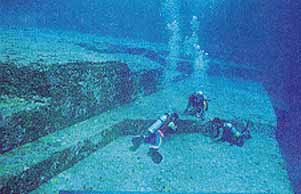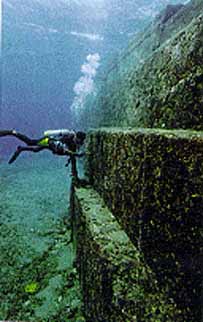Skip to comments.
Divers find remains of six 'lost temples'
The Telegraph (U.K.) ^
| 04/11/2002
| David Derbyshire
Posted on 04/10/2002 5:54:43 PM PDT by Pokey78
A MYSTERIOUS settlement that sank beneath the waves at least 1,200 years ago has been discovered by divers off the south-east coast of India.
Granite blocks and walls that lie 20ft below the surface may be the remains of six "lost temples" that form part of local mythology.
The ruins came to light after the controversial amateur archaeologist and best-selling author Graham Hancock interviewed fisherman for a recent television series.
After hearing accounts of the myth of a submerged city, he and two dozen divers searched the sea bed last week.
India's National Institute of Oceanography, which was involved in the discovery, believes the ruins at Mahabalipuram in Tamil Nadu could be 1,200 to 1,500 years old.
But Mr Hancock, who argues that civilisation predates the ancient Egyptians and Sumerians by thousands of years, believes the city could go back to 3,000 BC.
The ruins were discovered half a mile off the coast by a team from the NIO and the UK-based Scientific Exploration Society. They include remains of walls and scattered carved blocks and stones and may cover several square miles.
According to local legend Mahabalipuram was once home to a great city. The gods became so jealous of its beauty that they sent a flood to swamp the city. Six temples were submerged, leaving just one on the shore.
TOPICS: Cuba; Culture/Society; United Kingdom
KEYWORDS: archaeology; atlantis; catastrophism; cuba; dwarka; ggg; godsgravesglyphs; grahamhancock; history; india; mahabalipuram; mamallapuram; pallava; paulinazelitsky; paulinazelitzky; ramsethu; scuba; southasialist; srilanka; tamilnadu; tsunami; unitedkingdom
Navigation: use the links below to view more comments.
first previous 1-20, 21-40, 41-60, 61-80, 81-95 next last
To: Atlantian
It's an old map used by a Turkish Admiral before the discovery of Antarctica.
URL. Unfortunately for historians, it shows part of the coastline of Antarctica, and what's more, the coastline is shown ice-free. If you look at the map you might or might not agree. It has been suggested that it was a redraw of some truly ancient maps, which was a common thing to do if you had some truly ancient maps.
To: RightWhale
Thanks, that's a great web site.
To: Atlantian
Glad you asked. Hapgood's proposal that there was a more advanced civilization on earth before the age of Phoenician maritime merchants deserves a good look. The Piri Re'is map is quite a clue.
To: RightWhale
Thanks for the link. I've never heard of it before.
To: BJClinton
You're more than welcome.
To: David
the pyramids are beyond our technical capability to duplicate today I didn't know this. Amazing.
To: RightWhale
" Hapgood's proposal that there was a more advanced civilization on earth before the age of Phoenician maritime merchants deserves a good look. The Piri Re'is map is quite a clue." Most of the answers are underwater. (I know you agree)
67
posted on
07/10/2002 8:39:17 PM PDT
by
blam
To: David
I am sure you know, the pyramids are beyond our technical capility to duplicate today.
I'm not sure I follow. Not only could we build the pyramids today, we could build them faster, cheaper and with greater durability.
To: Atlantian
"the pyramids are beyond our technical capability to duplicate today I didn't know this. Amazing.
The largest and oldest pyramid ever discovered is in South America. The base of this SA pyramid is 7 times larger than the largest in Egypt. Keep your eyes on South America for some very suprising discoveries in the near future.
69
posted on
07/10/2002 8:45:32 PM PDT
by
blam
To: blam
The base of this SA pyramid is 7 times larger than the largest in Egypt 2.6 times longer and 2.6 times wider. Is it higher?
To: RightWhale
"2.6 times longer and 2.6 times wider. Is it higher?" I was sure the guy said 7 times, I saw this the other night on a documentary tilted Pyramids, Mummies and Tombs, I believe it was called. I don't think it was taller.
71
posted on
07/11/2002 9:00:55 AM PDT
by
blam
To: blam
BUMP
To: BJClinton; Atlantian
"I'm not sure I follow. Not only could we build the pyramids today, we could build them faster, cheaper and with greater durability." Not so! Now normally when somebody says that to me, my usual response is "ok--why not?" There are a number of reference texts that explain what the problems are. Most significant technical problem is that we cannot achieve the tolerances of the block fits with carved stone and can't achieve the hardness of the blocks from any other stone based material. There are other issues but there are a number of texts out there which deal with this kind of problem. The best one I have had in my personal library I loaned to an architect friend of mine (who is an expert in stone and poured composite structures) who has not given it back--done by some composite scientist in Europe, his hypothesis is that the blocks were poured in place although his bottom line is that we lack the technical capability to do it that way today either.
73
posted on
07/12/2002 8:51:54 AM PDT
by
David
To: NYer
That photo of Art Bell could be a computer generated
amalgamation of the 3 Lone Gunmen from the X-Files.
74
posted on
07/12/2002 8:58:07 AM PDT
by
Wm Bach
To: EU=4th Reich
Does anyone recall the NAZIs were very much into this kind of pseudo-science to support their Neo-paganism? I also recall that they were into other such pseudo-science as nuclear fission, rockets and the first jet engines.
What's your point?
To: blam
The largest and oldest pyramid ever discovered is in South America. What about this one?
A STRUCTURE thought to be the world's oldest building, nearly twice the age of the great pyramids of Egypt, has been discovered. The rectangular stone ziggurat under the sea off the coast of Japan could be the first evidence of a previously unknown Stone Age civilisation, say archeologists.
The monument is 600ft wide and 90ft high and has been dated to at least 8000BC. The oldest pyramid in Egypt, the Step Pyramid at Saqqara, was constructed more than 5,000 years later.


UNDERWATER PYRAMIDS
76
posted on
07/12/2002 9:19:25 AM PDT
by
NYer
To: NYer
"What about this one?" I have my fingers crossed that it turns out to be man made, but, the 'jury' is still out on this one.
77
posted on
07/12/2002 10:57:38 AM PDT
by
blam
To: David
I understand your point about emulating their techniques, but today we could do better. Whether the Egyptian pyramids were made with hewn stone, poured concrete or clay and straw bricks, we have much better capabilities today.
We have access to a wider variety of materials (marble, granite, steel, concrete) and we have heavy machinery.
To: EU=4th Reich
Isn't this the same 'Graham Hancock'Hancock is author of The Sign and the Seal, an excellent, intriguing exploration of his research and analysis of same re the Ark of the Covenant. Highly recommend it.
To: BJClinton
They also carved diorite to close tolerances, which is a pretty nifty trick in
any age.
80
posted on
07/12/2002 1:47:24 PM PDT
by
Wm Bach
Navigation: use the links below to view more comments.
first previous 1-20, 21-40, 41-60, 61-80, 81-95 next last
Disclaimer:
Opinions posted on Free Republic are those of the individual
posters and do not necessarily represent the opinion of Free Republic or its
management. All materials posted herein are protected by copyright law and the
exemption for fair use of copyrighted works.
FreeRepublic.com is powered by software copyright 2000-2008 John Robinson

